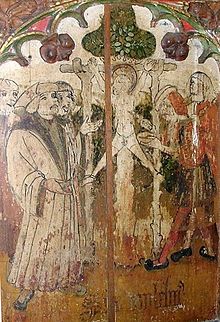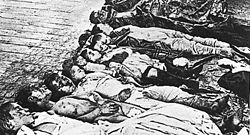
A | B | C | D | E | F | G | H | CH | I | J | K | L | M | N | O | P | Q | R | S | T | U | V | W | X | Y | Z | 0 | 1 | 2 | 3 | 4 | 5 | 6 | 7 | 8 | 9
This article includes a list of general references, but it lacks sufficient corresponding inline citations. (March 2023) |
| Part of a series on |
| Antisemitism |
|---|
 |
|
|
Antisemitism—prejudice, hatred of, or discrimination against Jews—has experienced a long history of expression since the days of ancient civilizations, with most of it having originated in the Christian and pre-Christian civilizations of Europe.
While it has been cited as having been expressed in the intellectual and political centers of ancient Greece and the Roman Empire, the phenomenon received greater institutionalization within European Christianity following the dissolution of the ancient center of Jewish culture, Jerusalem, resulting in the forced segregation of Jewish populations and restrictions on their participation in the public life of European society at times.
In the 20th century, antisemitism in Europe, particularly during the reign of Nazi Germany, resulted in the Holocaust, a program of systematic murder and dislocation of the majority of Europe's Jewish population.
Roman Empire
Middle Ages

Antisemitism in Europe in the Middle Ages was largely influenced by the Christian belief that the Jewish people were collectively responsible for the death of Jesus through the so-called blood curse of Pontius Pilate in the Gospels.
Persecutions against Jews were widespread during the Crusades, beginning in 1095, when a number of communities, especially in France and the Rhineland, were massacred.[1]
On many occasions, Jews were accused of the ritual murder of Christian children in what were called blood libels. The first known blood libel was the story of William of Norwich (d. 1144), whose murder sparked accusations of ritual murder and torture by the local Jews.[2]
The Black Death which devastated Europe in the 14th century also gave rise to widespread persecution. In the face of the terrifying spread of the plague, the Jews served as scapegoats and were accused of poisoning the wells. As a result, many Jewish communities in western and central Europe were destroyed in a wave of violence between 1348 and 1350.[3][4] For example, some two thousand Jews were massacred by burning in Strasbourg, in February 1349, upon a decision by the city council, before the plague had reached the city.[5][6] In the German states a total of approximately 300 Jewish communities were destroyed during this period, because of Jews being killed or driven out.[7]
Another aspect of medieval antisemitism was the many restrictions imposed on the Jews. They were excluded from many occupations because of the fear of competition with the local population. For the most part, they could not own land, since, under the feudal system, the pledge of loyalty required from a vassal upon the enfeoffment of land had the form of a Christian oath; however, there were exceptions.[8][9] Their residence in cities was often limited to specific areas known as ghettos. Following the Fourth Lateran Council, in 1215, Jews were also ordered to wear distinctive clothing,[10][11] in some instances a circular badge.[12] Some Jews managed to evade the humiliating requirement of wearing a badge by bribing the local authorities.[13]
In the later Middle Ages, Jews were expelled from smaller and larger regions across western Europe as well as the German lands, including monarchy-wide expulsions from England, in 1290, and France, in 1306 and 1394.[14] The greatest expulsions of Jews were in Spain (1492) and Portugal (1496), where Jews were ordered to convert to Christianity, or to leave the country within six or eleven months, respectively.[15]
The Protestant Reformation saw a rise of antisemitism with Martin Luther's On the Jews and Their Lies. Martin Luther and antisemitism proved that the Protestant church would be virulent to the Jews.
16th to 18th centuries
The Renaissance, Enlightenment and imperialist eras led to a series of increasingly xenophobic and non-religious expressions of antisemitic phobias and outrages, even as much of the continent had experienced significant political reformation.[16][17]
In western Europe, Jews were largely limited by local monarchs, especially as a consequence of the growing fear of competition with the local merchants due to the fact that the main occupation of Jews was commerce and banking. Notable examples are the limitation of the number of Jews allowed to settle in Breslau issued by Frederick II of Prussia in 1744 and the banishment of Jews from Bohemia by the archduchess of Austria Maria Theresa, who later also stated that Jews had to pay for remaining in the country.[18]
With the development of the banking system and the need of rulers for financing their growing state apparatus, the term "Court Jew" was used in some western European states. The court Jews were businessmen and bankers who received privileges from the sovereign and acted as their treasurers and tax collectors.[19][20]
In many cases, the court Jews obtained significant power as the "right hand" of the sovereign; in other cases, the court Jews were blamed for the financial problems of the states or when the sovereign lost his power. One notable court Jew was Joseph Süß Oppenheimer (1698–1738) the financial planner for Duke Karl Alexander of Württemberg in Stuttgart. Oppenheimer was executed after the death of the Duke and his story was used by Nazi propaganda.[21]
Most of Europe's Jewish population was concentrated in central and eastern Europe within the borders of the Polish–Lithuanian Commonwealth. The Jews of Poland had been granted an unprecedented degree of religious and cultural autonomy since the Statute of Kalisz in 1264, which was ratified by subsequent Kings of Poland and the Commonwealth. Nevertheless, the Cossack uprising of Bohdan Khmelnytsky in Polish-controlled Ukraine (1648) devastated many Jewish communities and tens of thousands of Jews were massacred, expelled, or sold as slaves by Khmelnytsky's Tartar allies. Between 1648 and 1656, tens of thousands of Jews—given the lack of reliable data, it is impossible to establish more accurate figures—were killed by the rebels, and to this day the Khmelnytsky uprising is considered by Jews to be one of the most traumatic events in their history.[22]
Following the Partitions of Poland by Russia, Prussia, and Austria at the end of the 18th century, most Polish Jews found themselves under Russian rule. In order to restrict the Jews from spreading throughout the Russian Empire and to protect Russian merchants from competition, the Pale of Settlement was established in 1772 by the empress of Russia Catherine II, restricting Jews to the western parts of the empire with the exception of a number of Jews who received permission to live in major cities, such as Kiev and Moscow.[23][24]
19th and early 20th century


By the end of the 19th century a new type of antisemitism had begun to develop in Europe, racial antisemitism.[25] It started as a part of a broader racist world view and belief of superiority of the "white race" over other "races", while existing prejudice was supported by pseudo-scientific theories such as Social Darwinism.[26]
The main idea of racial antisemitism, as presented by racial theorists such as Joseph Arthur de Gobineau, is that the Jews are a distinct and inferior race compared to the European nations. The emphasis was on the non-European origin and culture of the Jews, meaning they were beyond redemption even if they converted to Christianity. This modern antisemitism emphasized hatred of the Jews as a race and not only due to their Jewish religion.
The rise of modern antisemitism together with the rise of nationalism and the nation state brought a wave of antisemitism as Jews struggled to gain their rights as equal citizens. In Germany, this brought up the Hep-Hep riots in 1819 when the Jews of Bavaria were attacked for claiming their civic rights.
Zdroj:https://en.wikipedia.org?pojem=Antisemitism_in_Denmark
Text je dostupný za podmienok Creative Commons Attribution/Share-Alike License 3.0 Unported; prípadne za ďalších podmienok. Podrobnejšie informácie nájdete na stránke Podmienky použitia.
Antropológia
Aplikované vedy
Bibliometria
Dejiny vedy
Encyklopédie
Filozofia vedy
Forenzné vedy
Humanitné vedy
Knižničná veda
Kryogenika
Kryptológia
Kulturológia
Literárna veda
Medzidisciplinárne oblasti
Metódy kvantitatívnej analýzy
Metavedy
Metodika
Text je dostupný za podmienok Creative
Commons Attribution/Share-Alike License 3.0 Unported; prípadne za ďalších
podmienok.
Podrobnejšie informácie nájdete na stránke Podmienky
použitia.
www.astronomia.sk | www.biologia.sk | www.botanika.sk | www.dejiny.sk | www.economy.sk | www.elektrotechnika.sk | www.estetika.sk | www.farmakologia.sk | www.filozofia.sk | Fyzika | www.futurologia.sk | www.genetika.sk | www.chemia.sk | www.lingvistika.sk | www.politologia.sk | www.psychologia.sk | www.sexuologia.sk | www.sociologia.sk | www.veda.sk I www.zoologia.sk
